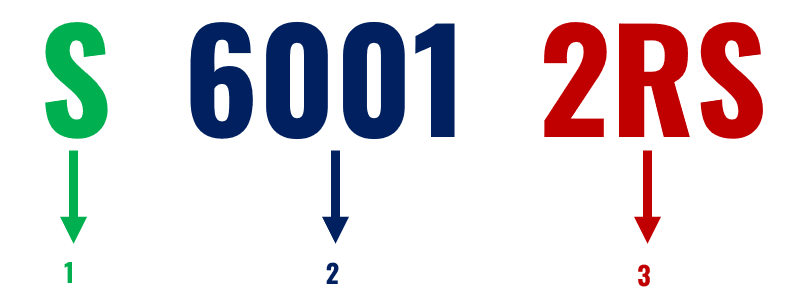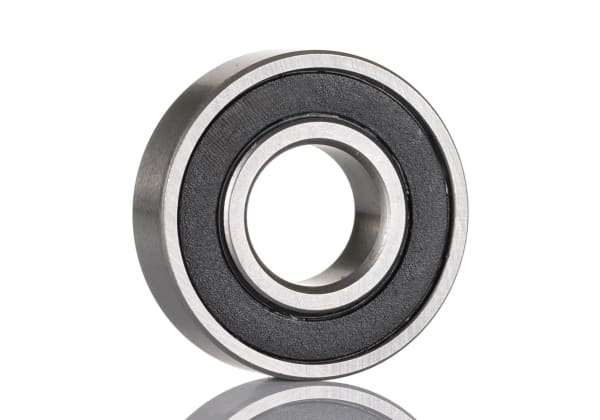- Published 13 Oct 2023
- Last Modified 12 Feb 2024
- 14 min
A Complete Guide To Ball Bearing Measurement, Bearing Sizes And Bearing Codes

Ball bearings are essential components in many mechanical systems, including vehicles, industrial machinery, and household appliances. They help reduce friction and allow for smooth movement between two surfaces. Selecting the correct ball bearing is vital for various reasons, as it directly affects the performance, efficiency, safety, and potential downtime of a wide range of machines and equipment. To ensure proper functioning, it is important to know the type and size of a ball bearing.
This guide aims to assist, you the customer in measuring ball bearings accurately to make sure you select the correct bearing for your specific application. Proper measurement is crucial in identifying the appropriate ball bearing size and type, as well as interpreting bearing codes to make an informed choice. Let’s go through the step-by-step process of measuring a ball bearing and understanding bearing codes.
Identify The Type Of Ball Bearing
Before measuring, it’s important to identify the type of ball bearing you have. There are several common types, such as deep groove ball bearings, angular contact ball bearings, and thrust ball bearings to mention a few. Each type has its own unique design, and it is essential to recognize the correct type you have for accurate measurements. For more information on the different types of ball bearings available please see our Ball Bearings Guide
How To Measure A Ball Bearing
Ball bearings usually have their identification code stamped or lasered on the outside diameter of the bearing itself, using this is the best way to ensure you select the right bearing.
However, over time this code can become illegible or possibly worn away. So, it is important to be able to measure a ball bearing correctly.
Determining the size of a ball bearing can be done by measuring its outer diameter (OD), bore size (ID), and width. These measurements are usually expressed in millimetres (mm). Using a calliper or a micrometer, you can accurately measure these dimensions.
Tools you’ll need
- Calliper or Micrometer (digital or manual)
- Notepad and pen for recording data
- Flat and clean surface for measurement
Step 1: Prepare Your Equipment
Zero or calibrate your digital calliper or micrometer according to the manufactures instructions.
Step 2: Measure The Bore Size - Inner Diameter (ID)
Place the ball bearing on a flat and clean surface. Take the caliper or micrometer and gently insert its jaws or anvils into the bore of the bearing. Ensure that the measuring tool is at a right angle to the bore. Once positioned correctly, read, and record the measurement displayed on the caliper or micrometer. This value represents the bore size or the Inner Diameter (ID) of the bearing.
Step 3: Measure The Outer Diameter (OD)
Next, measure the outer diameter of the ball bearing. Position the measuring tool on the flat surface and place the outer edges of the caliper or micrometer jaws or anvils against the opposite sides of the bearings outer surface. Ensure the tool is at a right angle to the bearing. Read and record the measurement displayed on the caliper or micrometer. This value represents the outer diameter of the bearing.
Step 4: Measure The Width (thickness)
For ball bearings with a cylindrical shape, measure the width or thickness of the bearing. Place the bearing on a flat clean surface and align the jaws or anvils of the measuring tool against opposite sides of the bearing. Read and record the measurement displayed on the caliper or micrometer. This value represents the width of the bearing.
Bearing Codes
So, what does the code on your bearing actually signify? Let’s dig a little deeper and explain in a bit more detail.
Typically bearing codes are comprised of a ‘basic number’ and depending on the bearing they can have supplementary codes at the beginning or the end of the basic number. These are the prefix and suffix codes.
The basic number will give you general information about the bearing such as the type, series number and bore size.
We will use a popular bearing (S) (6001) (2RS) as our example

Start by breaking down the code on your bearing into 3 parts
- S (prefix)
- 6001 (basic number)
- 2RS (suffix)
Prefix
Bearings very rarely have a prefix code. However, you may come across one that does. The prefix is used to highlight the parts used by the manufacturer in the design of the bearing. In our example where we have a Prefix of (S) it tells us that the bearing was made using stainless steel. Below are a couple of common examples
Prefix | Meaning |
|---|---|
W | Stainless Steel (SKF) |
S | Stainless Steel (FAG) |
Basic Number First Digit
The first digit of the basic number tells you about the type of bearing you have. In our example, it’s (6) So this tells us it’s a Single row deep groove ball bearing.
Bearing Type Code | Bearing Name |
|---|---|
1 | Self-aligning Ball Bearing |
2 | Spherical Roller Bearing |
3 | Double Row Angular Contact Ball Bearing |
4 | Double Row Ball Bearing |
5 | Thrust Ball Bearing |
6 | Single Row Deep Groove Ball Bearing |
7 | Single Row Angular Contact Bearing |
8 | Felt Seal Bearing |
N | Cylindrical Roller Bearing |
NN | Double Row Roller Bearing |
NA | Needle Roller Bearing |
BK | Needle Roller Bearing with closed end (drawn cup) |
HK | Needle Roller Bearing with open ends (drawn cup) |
C | CARB Toroidal Roller Bearings |
QJ | Four-point Contact Ball Bearing |
Basic Number Second Digit
The second digit of the basic number tells us what series the bearing is from and is used to signify how tough the bearing is. In our example, it’s (0) Which tells us its extra light toughness.
Series Code | Series Code Meaning |
|---|---|
0 | Extra Light |
1 | Extra Light Thrust |
2 | Light |
3 | Medium |
4 | Heavy |
8 | Extra Thin Section |
9 | Very Thin Section |
Basic Number Third And Fourth Digit
The third and fourth digits tell you the bore size or (ID) of the bearing you have. In our example, it’s (0) which tells us the bearing has a 12 mm bore size.
Important Note that from 20mm and above you would need to times (x) the last 2 digits by 5 to ascertain the bore size for nearly all types of bearing.
Third and Fourth Digit | Bore Size (mm) |
|---|---|
00 | 10 |
01 | 12 |
02 | 15 |
03 | 17 |
From hereafter (x5) | |
04 | 20 |
05 | 25 |
And so on……… |
Suffix
Suffixes indicate bearings with additional special characteristics or designs. They are typically used to provide information about how the bearing is sealed. In our example, it’s (2RS) which tells us our bearing is sealed on both sides.
Suffix | What do they mean? |
|---|---|
Z | One side of the bearing is shielded |
ZZ | Both sides of the bearing is shielded |
RS | One side of the bearing is sealed |
2RS or DDU | Both sides of the bearing is sealed |
C3 | Larger clearance |
K | Taper bore |
NR | Snap ring groove |
M or MB | Machined brass cage |
Clearance Codes
In some cases, your bearing may have an additional suffix such as C3. This can be found on the outside diameter of the bearing except in the case of CN. This refers to the bearings clearance code. See the table below for examples.

Suffix | Clearance |
|---|---|
C1 | Less than C2 |
C2 | Less than normal |
CN | Normal |
C3 | Greater than normal |
C4 | Greater than C3 |
C5 | Greater than C4 |
It is important to note that different manufacturers can have their own specific Prefix and Suffix codes. Our tables give you some examples of the most common codes. If in doubt please check with the manufacturer of your bearing for exact information.
Table Of Sizes
So now you have a better understanding of how to measure a ball bearing and how to interpret a bearing code, why not check out our great range of high-quality bearings from industry-leading brands such as SKF, NSK, FAG, INA and of course our own brand RS PRO.
We have created a list of the most popular sizes to make it quicker and easier for you to identify and purchase the exact ball bearing for your application. Simply click on your size and view our current selection.
Single Row Deep Groove Ball Bearing Measurements
Self Aligning Ball Bearing Measurements
Size | Inner Dimension (mm) | Outer Dimension (mm) | Width (mm) | |
|---|---|---|---|---|
1202 | 15 | 35 | 11 | Shop All 1202 Bearings |
1204 | 20 | 47 | 14 | Shop All 1204 Bearings |
1205 | 25 | 52 | 15 | Shop All 1205 Bearings |
1206 | 30 | 62 | 16 | Shop All 1206 Bearings |
1207 | 35 | 72 | 17 | Shop All 1207 Bearings |
1208 | 40 | 80 | 18 | Shop All 1208 Bearings |
1209 | 45 | 85 | 19 | Shop All 1209 Bearings |
1210 | 50 | 90 | 20 | Shop All 1210 Bearings |
1211 | 55 | 100 | 21 | Shop All 1211 Bearings |
1212 | 60 | 110 | 22 | Shop All 1212 Bearings |
1213 | 65 | 120 | 23 | Shop All 1213 Bearings |
1215 | 75 | 130 | 25 | Shop All 1215 Bearings |
1216 | 80 | 140 | 26 | Shop All 1216 Bearings |
1217 | 85 | 150 | 28 | Shop All 1217 Bearings |
1218 | 90 | 160 | 30 | Shop All 1218 Bearings |
Single Row Angular Contact Ball Bearing Measurements
Size | Inner Dimension (mm) | Outer Dimension (mm) | Width (mm) | |
|---|---|---|---|---|
7200 | 10 | 30 | 9 | Shop All 7200 Bearings |
7201 | 12 | 32 | 10 | Shop All 7201 Bearings |
7202 | 15 | 35 | 11 | Shop All 7202 Bearings |
7203 | 17 | 40 | 12 | Shop All 7203 Bearings |
7204 | 20 | 47 | 14 | Shop All 7204 Bearings |
7205 | 25 | 52 | 15 | Shop All 7205 Bearings |
7206 | 30 | 62 | 16 | Shop All 7206 Bearings |
7207 | 35 | 72 | 17 | Shop All 7207 Bearings |
7208 | 40 | 80 | 18 | Shop All 7208 Bearings |
7209 | 45 | 85 | 19 | Shop All 7209 Bearings |
7305 | 25 | 62 | 17 | Shop All 7305 Bearings |
7306 | 30 | 72 | 19 | Shop All 7306 Bearings |
7307 | 35 | 80 | 21 | Shop All 7307 Bearings |
7308 | 40 | 90 | 23 | Shop All 7308 Bearings |
7309 | 45 | 100 | 25 | Shop All 7309 Bearings |
7310 | 50 | 110 | 27 | Shop All 7310 Bearings |
7311 | 55 | 120 | 29 | Shop All 7311 Bearings |
7312 | 60 | 130 | 31 | Shop All 7312 Bearings |
7314 | 70 | 150 | 35 | Shop All 7314 Bearings |
Double Row Angular Contact Ball Bearing Measurements
Size | Inner Dimension (mm) | Outer Dimension (mm) | Width (mm) | |
|---|---|---|---|---|
3200 | 10 | 30 | 14 | Shop All 3200 Bearings |
3201 | 12 | 32 | 15.9 | Shop All 3201 Bearings |
3202 | 15 | 35 | 15.9 | Shop All 3202 Bearings |
3203 | 17 | 40 | 17.5 | Shop All 3203 Bearings |
3204 | 20 | 47 | 20.6 | Shop All 3204 Bearings |
3205 | 25 | 52 | 20.6 | Shop All 3205 Bearings |
3206 | 30 | 62 | 23.8 | Shop All 3206 Bearings |
3207 | 35 | 72 | 27 | Shop All 3207 Bearings |
3208 | 40 | 80 | 30.2 | Shop All 3208 Bearings |
3209 | 45 | 85 | 30.2 | Shop All 3209 Bearings |
3210 | 50 | 90 | 30.2 | Shop All 3210 Bearings |
3304 | 20 | 52 | 22.2 | Shop All 3304 Bearings |
3305 | 25 | 62 | 25.4 | Shop All 3305 Bearings |
3306 | 30 | 72 | 30.2 | Shop All 3306 Bearings |
3307 | 35 | 80 | 34.9 | Shop All 3307 Bearings |
3308 | 40 | 90 | 36.5 | Shop All 3308 Bearings |
Thrust Ball Bearing Measurements
Size | Inner Dimension (mm) | Outer Dimension (mm) | Width (mm) | |
|---|---|---|---|---|
51100 | 10 | 24 | 9 | Shop All 51100 Bearings |
51101 | 12 | 26 | 9 | Shop All 51101 Bearings |
51102 | 15 | 28 | 9 | Shop All 51102 Bearings |
51103 | 17 | 30 | 9 | Shop All 51103 Bearings |
51104 | 20 | 35 | 10 | Shop All 51104 Bearings |
51105 | 25 | 42 | 11 | Shop All 51105 Bearings |
5106 | 30 | 47 | 11 | Shop All 5106 Bearings |
51107 | 35 | 52 | 12 | Shop All 51107 Bearings |
51108 | 40 | 60 | 13 | Shop All 51108 Bearings |
51109 | 45 | 65 | 14 | Shop All 51109 Bearings |
Summary
In conclusion, mastering the art of measuring ball bearings and understanding bearing codes is vital for anyone involved in mechanical or industrial applications. By following the steps outlined in this guide, you can confidently and accurately determine crucial parameters like inner and outer diameters, width, and radial play.
Furthermore, decoding bearing designations enables you to select the right bearing for your specific needs, optimizing performance and longevity. Remember that precision is paramount, and a well-measured bearing is essential for efficient machinery and reliable operation.

Reviewed by Malcom Watson (Technical Product Engineer for RS Group)
I have over 40 years of experience in Mechanical Power Transmission specialising in Bearings (covering Technical roles and Product Management). I am always motivated to learn more as new bearing innovations are regularly introduced to the market by our leading brands offering even better solutions to customers. Improving downtime and increasing efficiency. Keeping industry moving!

